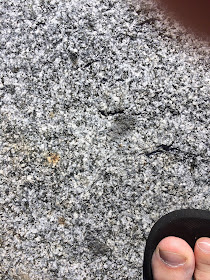 |
| Rockvale Monzogranite and my toes for scale |
It has been a long time since I wrote a blog post. Life has got in the way with a unexpected sorrow in the death of my little lady. It has been a year of change and that includes work and new ventures. Now, I begin the journey of working for myself. In saying that, if you have any work that might interest me I’d love to chat to you about it. I don’t have a web page at this stage, but I have my contact details on this page. Already, I have had the opportunity to work in the North Coast again, renewing old and making new contacts. I am still based in the New England area and as always it is an adventure to explore the land and environment.
The first post I want to do is one about an arsenic mine I visited near Armidale. When I visited the Rockvale Arsenic Mine it was quite evident that the site has contaminated the soil. The most widespread contaminant in the region is antimony metal which when mined (along with gold) in the Hillgrove district and was discharged in large volumes into the Macleay River catchment. This antimony continues to be dissolved in water flowing from the old Hillgrove and other abandoned areas. However, further upstream from Hillgrove, in the Wollomombi River catchment from is Rockvale which has a similar geological history.
 |
| Rockvale Arsenic mine |
 |
| Possible evidence of contaminated soil transport (gully erosion) |
Rockvale is named for its rocks! Granite types that cover a very large area. The rock unit is called the Rockvale Monzogranite of the Hillgrove Supersuite. It was formerly known as the Rockvale Adamellite, in the old nomenclature. According to Kent (1994) the Rockvale Monzogranite consists of 20 individual plutons all intruded during the Carboniferous (at approximately 303Ma). The surrounding rock into which it intruded and metamorphosed the Girrakool Beds. The metamorphic effects are quite significant and extend for quite some distance from the Rockvale Monzogranite. Interestingly, there are many hydrothermal mineral deposits in the Rockvale Monzogranite and adjacent metamorphic rocks, yet the mineral deposits were formed 50Ma later (approximately 250Ma). This situation is similar to the nearby Hillgrove mines which although spatially appear to be directly related to the Hillgrove Monzogranite but are actually later concentrations of hydrothermal minerals.
The number of old mines is the Rockvale area is quite significant. Some have been rehabilitated, some badly rehabilitated and others still discharge metal contaminants into the receiving environment. The Rockvale Arsenic mine is a good example, it appears to be the northern most of several mineral deposits that occur along a line a couple of kilometres long, possibly terminating at the Ruby Silver Mine. The main mineral mined from the hillgrove arsenic mine was arsenopyrite, though other less common arsenic minerals were also part of the ore. The arsenic was 'roasted' to drive of volatile elements and concentrate the ore.
The legacy of historical operations can be seen from the photograph which shows extensive bare areas and gully erosion due to the metal toxicity and acid mine waste from oxidised pyrite, arsenopyrite and other sulfide minerals. So, although the metal contamination from downstream Hillgrove is well known, a baseline study will obviously provide some indication that contamination is coming from other upstream sources too. It will be interesting to see how much.
References/bibliography
*Ashley, P. & Graham, B. 2001.
Heavy metal loadings of streams in
the Macley River catchment. Report to the Mid North Coast Catchment
Management Board, NSW Department of Mineral Resouces & Armidale
Dumaresq Council.
*Craw, D., Wilson, N. & Ashley, P.M. 2004.
Geochemical controls on the environmental mobility of Sb and As at
mesothermal antimony and gold deposits. Applied Earth Sciences
(Transactions of the Institute of Mining and Metallurgy) vol 133 B3.
*Kent, A.J.R. (1994)
Geochronology and geochemistry of Palaeozoic intrusive rocks in the Rockvale region, southern New England Orogen, New South Wales. Australian Journal of Earth Sciences 14:4
*McClatchie & Sylvester. 1970.
The Tulloch Silver mine. Records of the Geological Survey of New South Wales. Vol 12, part 1.









